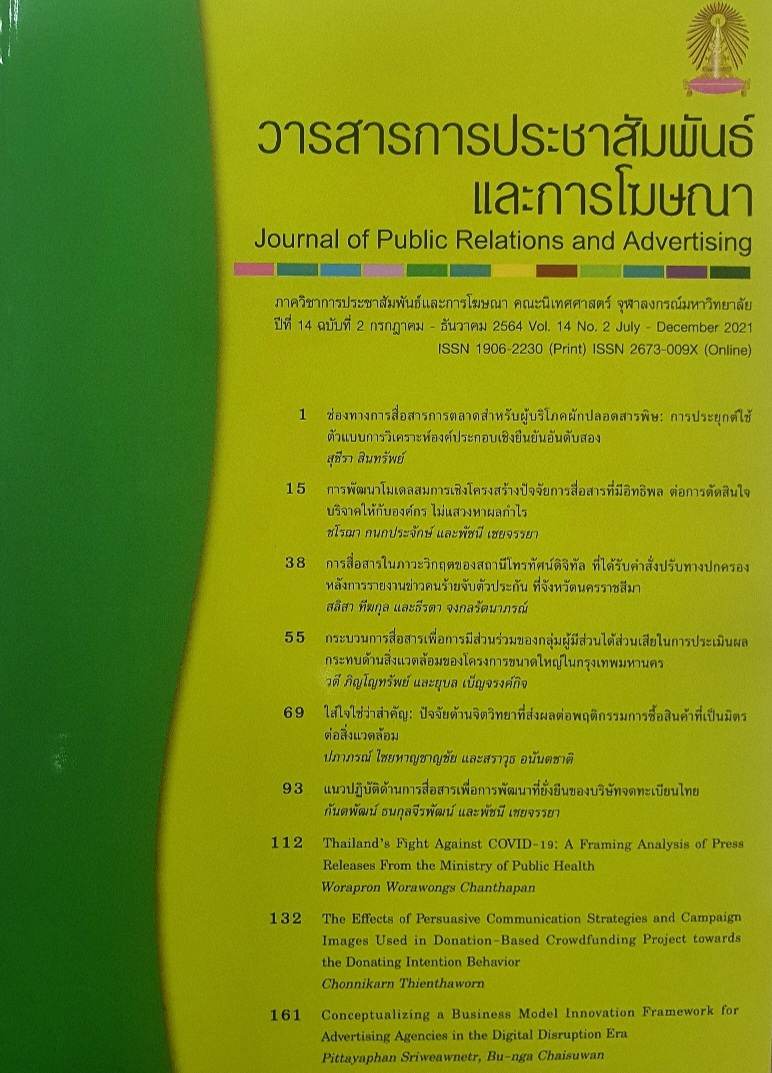Marketing Communication Channels for Organic Vegetables Consumers: Applied Second-order Confirmatory Factor Analysis Model
Main Article Content
Abstract
The objective of this research was to examine the concordance of marketing communication channel model of the organic vegetable consumer and empirical evidence. The sample consisted of 400 organic vegetables consumers in Udon Thani Province. The research instrument was a questionnaire with 5-level rating scale. Data were analyzed by Second-order Confirmatory Factor Analysis. The results revealed that the suitable marketing communication channel model for organic vegetables consumers were 3 elements, 11 variables as follows: advertising elements consisting of television, radio, newspapers and magazines, public relations elements including print media, trade show and celebrity, and direct marketing elements including catalogs, direct mail, booth display, fair. The result showed that the model was consistent with empirical data, considering the chi-square () was 34.99, the relative chi-square (/ df) was 1.521, Goodness of Fit Index (GFI) was 0.98 and Adjusted Goodness of Fit Index (AGFI) was 0.95. Root mean square error of approximation (RMSEA) was 0.036 and Standard Root Mean Residual (Standardized RMR) was 0.015
Article Details
References
กมล ชัยวัฒน์. (2553). รายงานการวิจัยเรื่อง การรับรู้การสื่อสารการตลาดแบบบูรณาการ (IMC) ของผู้บริโภคต่อการตัดสินใจซื้อผลิตภัณฑ์อินทรีย์. กรุงเทพฯ: มหาวิทยาลัยศรีปทุม.
กัลญา กนกวิมาน. (2559). รูปแบบการสื่อสารการตลาดแบบผสมผสานที่มีอิทธิพลต่อการบริโภคสินค้าเกษตรอินทรีย์ของกลุ่มเบบี้บูมเมอร์ส ในกรุงเทพมหานคร. วิทยานิพนธ์ ปริญญาศิลปศาสตรมหาบัณฑิต (นิเทศศาสตร์และสารสนเทศ) มหาวิทยาลัยเกษตรศาสตร์.
ชื่นจิตต์ แจ้งเจนกิจ. (2556). IMC & Marketing Communication กลยุทธ์การสื่อสารการตลาด. พิมพ์ครั้งที่ 6. กรุงเทพฯ: แบรนด์เอจ บุ๊คส์.
ดุษฎี พรหมทัต. (2558). พฤติกรรมการผลิตผักปลอดภัยของเกษตรกร จังหวัดพระนครศรีอยุธยา. วารสารวิจัยสหวิทยาการไทย, 10(3), 9-16.
ธีรพันธ์ โล่ทองคำ. (2551). Inside IMC เจาะลึกถึงแก่นไอเอ็มซี. กรุงเทพฯ: โอเอส พริ้นติ้ง.
เบญจมาศ จันทร์แก้ว. (2551). รายงานการวิจัยเรื่องการวิเคราะห์ทางเศรษฐกิจของการผลิตผักโดยการใช้สารธรรมชาติและสารเคมี. กรุงเทพฯ: มหาวิทยาลัยเกษตรศาสตร์.
ปฐมาพร เนตินันทน์. (2561). การศึกษาเปรียบเทียบความสัมพันธ์ระหว่างการเปิดรับสื่อดั้งเดิมและสื่อใหม่กับพฤติกรรมการบริโภคของ “เจน วาย” ในเขตกรุงเทพและปริมณฑล. วารสารการจัดการสมัยใหม่, 16(2), 57-69.
ปณิชามน ตระกูลสม. (2559). กลยุทธ์ของการจัดงานแสดงสินค้า เครื่องมือสื่อสารการตลาด สร้างประสบการณ์ให้ผู้บริโภค. วารสารการสื่อสารและการจัดการ นิด้า, 2(3), 62-78.
พิชามญชุ์ วงศ์เวช. (2558). การตอบสนองของผู้ซื้อในอำเภอเมืองเชียงใหม่ต่อส่วนประสมการสื่อสารทางการตลาดของผัก
ออร์แกนิก. การค้นคว้าอิสระ ปริญญาบริหารธุรกิจมหาบัณฑิต สาขาวิชาการจัดการอุตสาหกรรมเกษตร มหาวิทยาลัยเชียงใหม่.
รุจาภา แพ่งเกษร. (2559). การบูรณาการสื่อการตลาดดั้งเดิมสู่สื่อการตลาดสมัยใหม่. เศรษฐศาสตร์และบริหารธุรกิจปริทัศน์, 12(1), 49-69.
ลออรัตน์ จิตต์พงษ์, เบญญาภา กาลเขว้า และ ประทีป กาลเขว้า. (2562). พฤติกรรมการบริโภคผักให้ปลอดภัยจากสารพิษของประชาชนบ้านแสนสำราญ ตำบลสามขา อำเภอกุฉินารายณ์ จังหวัดกาฬสินธุ์. วารสารสภาการสาธารณสุขชุมชน, 1(1), 53-60.
วชิระ น้อยนารถ, พัชราวดี ศรีบุญเรือง และ สาวิตรี รังสิภัทร์. (2560). ปัจจัยที่มีความสัมพันธ์ต่อการตัดสินใจซื้อสินค้าเกษตรปลอดสารพิษของผู้บริโภค ร้านโกลเด้น เพลซ สาขามหาวิทยาลัยเกษตรศาสตร์. วารสารเกษตรพระจอมเกล้า, 35(1), 136-145.
ศิริรัตน์ แตงแดง. (2562). ช่องทางการสื่อสารการตลาดที่ส่งผลต่อพฤติกรรมการซื้อข้าวอินทรีย์ของผู้บริโภคในประเทศไทย. วิทยานิพนธ์ ปริญญาศิลปศาสตรมหาบัณฑิต สาขาวิชาการสื่อสารการตลาด มหาวิทยาลัยเทคโนโลยีราชมงคลพระนคร.
สำนักงานเกษตรและสหกรณ์ จังหวัดอุดรธานี. (2563). ข้อมูลพื้นฐานด้านการเกษตรและสหกรณ์ของจังหวัดอุดรธานี ประจำเดือน ต.ค.2563. วันที่เข้าถึงข้อมูล 15 กุมภาพันธ์ 2564, แหล่งที่มา https://www.opsmoac.go.th/udonthani-dwl-preview-422791791807
สำนักงานจังหวัดอุดรธานี. (2561). แผนพัฒนาจังหวัดอุดรธานี พ.ศ.2561 – 2565 ฉบับทบทวน ประจำปีงบประมาณ พ.ศ.2563. อุดรธานี: กลุ่มงานยุทธศาสตร์และข้อมูลเพื่อการพัฒนาจังหวัด สำนักงานฯ.
สุภมาส อังศุโชติ, สมถวิล วิจิตรวรรณา และ รัชนีกูล ภิญโญภานุวัฒน์. (2551). สถิติวิเคราะห์สำหรับการวิจัยทางสังคมศาสตร์และพฤติกรรมศาสตร์ เทคนิคการใช้โปรแกรม LISREL. กรุงเทพฯ: มิสชั่น มีเดีย.
Bollen, K. A. (1989). Structural Equations with Latent Variables. New York: Wliey.
Cochran, W. G. (1977). Sampling Techniques. (3rd ed.). New York: John Wiley and Sons.
Diamantopoulos, A., & Siguaw, J. A. (2000). Introduction to LISREL: A guide for the uninitiated. London: SAGE.
Duncan, T. R. (2002). Using Advertising and Promotion to Build Brands. New York: McGraw-Hill.
Duncan, T. R. (2005). Principles of Advertising & IMC. (2nd ed.). Boston, Mass.: McGraw-Hill.
Fill, C. (1995). Marketing Communication: Frameworks, Theories and Application. New Jersey: Prentice Hall.
Hu, L. T., and Bentler, P. M. (1999). Cutoff criteria for fit indexes in covariance structure analysis: Conventional criteria versus new alternative. Structural equation modeling, 6(1), 1-55.
Joreskog, K. D., and Sorbom, D. (1989). Lisrel 7: User’s Reference Guide. Chicago: Scientific Software International.
Kotler, P. (2003). Marketing Management. (11th ed.). Upper Saddle River, NJ: Prentice Hall.
Kotler, P., & Keller, K. L. (2012). Marketing Management. (12th Ed.). Edinburgh Gate: Pearson Education.
Ruswanti, E., Gantino, R., & Sihombing, S. (2019). Predicting The Influence of Integrated Marketing Communication on Intention to Buy Organic Product: An Empirical Study. Humanities & Social Sciences Reviews, 7(3), 32-37.
Schultz, D. E., Tannenbaum, S. T., & Lauterborn, R. F. (1994). Integrated Marketing Communications. Chicago, IL: NTC Business Books.
Shimp, T. A. (2000). Advertising, Promotion and Supplemental Aspects of Integrated Marketing Communications. (5th ed.). Orlando, FL: Dryden Press.
Shimp, T. A., & Andrews, J. C. (2013). Advertising, Promotion, and other aspects of Integrated Marketing Communications. (9th ed.). Ohio, U.S.A.: South-Western.

